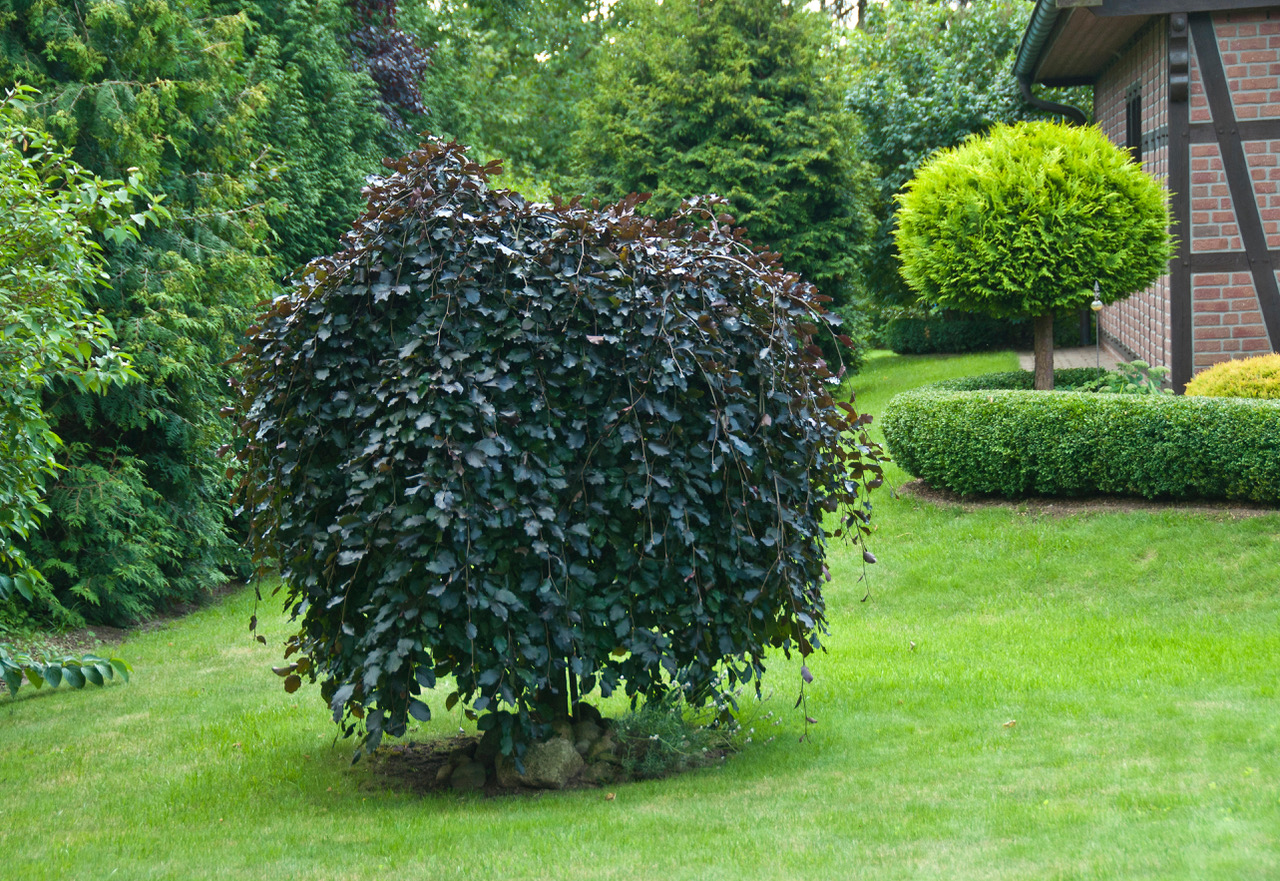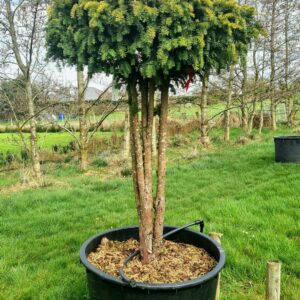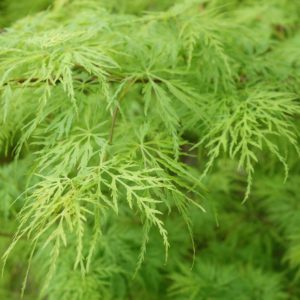Fagus syl. purpurea pendula (weeping purple beech)
€350.00
Frequently Bought Together



Description
Quick Facts
- Common Name: Weeping Purple Beech, Weeping Copper Beech
- Botanical Name: Fagus sylvatica ‘Purpurea Pendula’
- Plant Type: Deciduous ornamental tree
- Mature Height: 4-6m
- Mature Spread: 2-4m
- Flowering Period: April to May (insignificant flowers)
- Flower Colour: N/A (grown for foliage and form)
- Foliage: Deep purple to copper-burgundy leaves, turning copper-bronze in autumn
- Hardiness: RHS H6 (fully hardy throughout UK and Ireland)
- Soil Requirements: Moist, well-drained, fertile soil; tolerates most soil types
- Aspect: Full sun to partial shade (best colour in full sun)
- Maintenance: Low to moderate (occasional pruning to shape)
Description
Experience the breathtaking beauty of Fagus sylvatica ‘Purpurea Pendula’, one of the most spectacular and dramatic weeping trees for gardens, where cascading branches clothed in rich deep purple foliage create living sculptures of extraordinary elegance and year-round drama, transforming gardens into theatrical displays of colour and form that captivate attention and bring romantic Gothic character with unmatched architectural presence. This exceptional cultivar offers remarkable qualities—stunning deep purple to burgundy-copper foliage emerging rich purple-red in spring and maintaining intense colour throughout summer creating constant dramatic focal point, extraordinary weeping habit with branches cascading vertically downward like purple waterfalls creating sculptural mushroom or fountain-shaped silhouette unlike any other tree, manageable compact size (3-5m depending on graft height) making it suitable for medium to large gardens where space is more limited than required for forest-sized trees, spectacular autumn transformation when purple leaves turn warm copper-bronze and russet tones before falling creating second season of colour, and exceptional hardiness thriving reliably throughout temperate climates with vigorous growth once established, making this one of the most prestigious and rewarding choices for adding dramatic purple foliage, weeping sculptural form, and year-round architectural presence to specimen plantings, focal points, and anywhere a truly unforgettable statement tree is desired to create Gothic romance and theatrical garden drama.
Throughout the seasons, this captivating tree displays its most spectacular features from spring through autumn—the foliage emerges in spring as rich purple-red to deep burgundy, each oval leaf measuring 6-10cm long with delicate wavy edges and prominent veining creating texture and movement. The young leaves have silky appearance with fine hairs catching light beautifully. As summer progresses, the foliage deepens to rich purple-burgundy with coppery undertones, the colour most intense in full sun positions where leaves appear almost black-purple in certain lights creating dramatic contrast against green gardens. In partial shade, the colour softens to purple-green but remains beautiful and distinctive. The weeping habit is the defining characteristic—branches grow vertically downward in dramatic cascades from the point of grafting, creating extraordinary sculptural form like a purple mushroom, fountain, or living waterfall. Unlike upright purple beeches, this cultivar has no upward growth—all branches weep directly downward creating dense curtains of purple foliage that can reach the ground if not pruned. The overall form is architectural and sculptural, often wider than tall, creating horizontal layers of cascading purple branches. The weeping branches move gracefully in breezes creating shimmering purple curtains. In autumn (October-November), the purple foliage undergoes beautiful transformation turning warm shades of copper, bronze, russet, and amber creating glowing displays before leaves fall. Following leaf drop, the elegant weeping branch structure is revealed—smooth silvery-grey bark on cascading branches creates beautiful winter silhouette like frozen purple waterfall. The overall effect throughout the growing season is dramatic, sculptural, and theatrical—like having a living purple sculpture or Gothic garden feature.
Fagus sylvatica (European Beech) is native to much of Europe including Britain and Ireland, where it forms magnificent forests and has been cultivated for centuries for timber, hedging, and ornamental use. The species name ‘sylvatica’ means “of the woods.” Purple-leaved forms (f. purpurea) arose as natural mutations and have been selected and cultivated since at least the 1600s, prized for their dramatic foliage colour. The weeping form ‘Purpurea Pendula’ combines the purple foliage with strongly pendulous habit—it’s grafted onto a standard rootstock at desired height (typically 1.5-2.5m), and all subsequent growth weeps downward from the graft point creating the characteristic mushroom or fountain shape. The height of mature specimens depends entirely on the graft height—trees grafted at 2m will remain approximately 3-4m tall (graft height plus weeping branches), while those grafted higher create taller specimens. This makes it more manageable than standard purple beeches which can reach 20-30m. Hardy to RHS H6, this robust tree thrives throughout UK and Ireland with complete reliability, tolerating cold winters, exposed positions, and variable weather. Moderate growth rate, adding 20-40cm annually once established, reaching impressive sculptural form within 10-15 years. Particularly valuable for dramatic purple foliage that provides constant colour from spring through autumn, extraordinary weeping sculptural form that creates instant focal point and architectural presence, manageable size suitable for medium to large gardens, and versatility in garden styles from formal to romantic to contemporary. Outstanding as specimen tree in prestigious gardens, focal points, and anywhere a truly dramatic statement tree is desired.
Create stunning compositions by planting as magnificent specimen tree on lawns where its extraordinary weeping purple form can be viewed from all angles and appreciated as dramatic focal point and living sculpture, positioning near seating areas, patios, or viewed from windows where the cascading purple foliage and sculptural form can be enjoyed up close and the movement of weeping branches appreciated, or using as focal point in formal gardens where the architectural form and rich colour create bold statement and Gothic elegance. Exceptional in contemporary gardens where the sculptural form and deep purple colour create modern drama paired with gravel, architectural perennials, and minimalist design, romantic cottage gardens where the weeping habit and rich colour fit perfectly with traditional plantings and create Gothic romance, or Japanese-inspired gardens where the sculptural form and seasonal colour changes create authentic character. Works beautifully planted as single specimen where the tree develops full weeping form and creates maximum dramatic impact, near water features or ponds where the weeping branches can reflect in water creating doubled purple beauty, or combined with contrasting foliage—golden-leaved trees (Gleditsia ‘Sunburst’, Robinia ‘Frisia’) for dramatic colour contrast, silver-leaved plants (Pyrus salicifolia ‘Pendula’, Elaeagnus ‘Quicksilver’) for complementary cool-warm contrast, or bright green backdrop (yew hedging, hornbeam) that emphasizes the purple colour. Also magnificent underplanted with shade-tolerant perennials (hostas, ferns, hellebores, epimediums) that thrive beneath the purple canopy and create layered planting, or surrounded by spring bulbs (white daffodils, bluebells) that bloom before tree fully leafs out creating white-purple contrast. Perfect for adding dramatic purple foliage, weeping sculptural form, and year-round architectural presence to specimen plantings, focal points, and anywhere a truly unforgettable statement tree is desired to create Gothic romance and theatrical garden drama.
Caragh Garden Notebook
Planting: Space trees 4-6m apart if planting multiple specimens, though most commonly planted as single focal point. Plant bare-root specimens November-March during dormancy (ideal for best establishment and value), or container-grown specimens year-round though autumn or early spring is preferred. Choose position in full sun for most intense purple colour—tolerates partial shade but colour will be less intense (more purple-green than deep purple). Requires open position with room for weeping branches to cascade without obstruction—avoid planting near paths or structures where weeping branches will interfere. Dig generous planting hole at least twice width of root ball and same depth. Incorporate organic matter (well-rotted compost, leaf mould) into backfill soil to improve fertility and moisture retention. Plant at same depth as nursery soil mark on trunk—the graft union (visible swelling where weeping top is joined to upright rootstock) should be above soil level. Backfill carefully, firming soil gently to eliminate air pockets. Water thoroughly after planting. Apply 5-8cm mulch of organic matter around base in 1m diameter circle, keeping mulch clear of trunk (10cm gap) to prevent rot. Stake securely using single stake positioned on windward side—use tree tie with spacer. Stake supports tree for first 2-3 years until established. Water regularly during first two growing seasons to establish deep root system. Position where the dramatic weeping purple form can be appreciated as focal point and where tree has room to develop full cascading habit.
Soil Preparation: Tolerates wide range of soil types including clay, loam, and chalky soils—beeches are notably lime-tolerant and thrive on alkaline soils. Prefers slightly acidic to alkaline pH (6.0-8.0) with best growth on neutral to alkaline soils. Requires moist, well-drained soil—avoid waterlogged or very dry soils. Improve heavy clay soils by incorporating organic matter and grit to improve drainage. Improve light sandy soils by adding generous amounts of compost or well-rotted manure to improve moisture retention and fertility. Beeches have shallow root systems, so consistent moisture during growing season is important. Mulch annually in spring with 5-8cm layer of organic matter (compost, leaf mould, well-rotted manure) in 1m diameter circle around base to conserve moisture, suppress weeds, improve soil fertility, and protect shallow roots. Keep mulch clear of trunk. Best growth and purple colour occur in full sun with moist, well-drained, fertile soil—these conditions produce the most vigorous growth and most intense purple foliage.
Container Growing: Not suitable for long-term container growing due to vigorous root system and eventual size—this is a substantial tree requiring in-ground planting for proper development. Young specimens can be grown in very large containers (minimum 80-100cm diameter) for 2-3 years to delay planting or for patio display, but will not thrive long-term in containers. If growing temporarily in containers, use soil-based compost (John Innes No. 3), water regularly, feed in spring, and plan to plant in ground within 2-3 years for best results.
Seasonal Care: Requires light to moderate pruning to maintain desired form and size. The weeping branches will grow to ground level if left unpruned—prune in late summer (July-August) after growth has finished to maintain desired height and shape. Can prune weeping branches to create clear space beneath tree for underplanting or access, or allow branches to reach ground for maximum dramatic effect. Remove any upward-growing shoots (reversions) that occasionally emerge from graft union or rootstock—these will have green leaves and upright growth and should be removed immediately to prevent them overtaking the weeping purple form. Prune out any dead, damaged, or crossing branches. CRITICAL: Avoid pruning during winter and early spring when sap is rising, as beeches “bleed” profusely from pruning cuts—always prune in late summer when sap flow is minimal. Apply general-purpose balanced fertiliser or blood, fish and bone in spring around base to promote healthy growth and intense purple colour. Mulch annually in spring. Water regularly during dry spells, particularly during first 3-5 years of establishment—beeches have shallow roots and struggle in drought, so water thoroughly during dry periods. Watch for aphids on new growth (spray with water or encourage natural predators), beech scale insects (white waxy deposits—treat with horticultural oil), and powdery mildew on leaves in dry conditions (improve air circulation). Generally disease-resistant with good air circulation. The purple foliage colour is reliably spectacular from spring through autumn!
Propagation: Cannot be propagated by home gardeners—this cultivar is created by grafting the weeping purple form onto upright Fagus sylvatica rootstock at desired height, a specialist technique requiring professional nursery facilities. The weeping top can be propagated from cuttings or layering, but requires rootstock grafting to create the characteristic tree form with weeping branches cascading from elevated graft point. Nursery-grown grafted specimens are essential for guaranteed weeping form and purple colour.
This spectacular beauty is absolutely breathtaking—one of the most dramatic weeping trees available! That stunning deep purple to burgundy-copper foliage maintaining intense colour from spring through autumn is absolutely stunning—creating constant dramatic focal point! Extraordinary weeping habit with branches cascading vertically downward like purple waterfalls creating sculptural mushroom or fountain-shaped silhouette—pure living sculpture! Manageable compact size (3-5m depending on graft height) suitable for medium to large gardens. Spectacular autumn transformation to warm copper-bronze tones. Fully hardy (RHS H6) throughout UK and Ireland—completely reliable! Best purple colour in full sun. CRITICAL: Prune only in late summer (July-August) to avoid bleeding—never prune in winter or spring! Remove any upward-growing green shoots immediately to maintain weeping purple form. Perfect for specimen plantings, focal points, formal gardens, contemporary gardens, and anywhere you want dramatic purple foliage with weeping sculptural form and Gothic romance. Pure theatrical magnificence and living purple sculpture!






